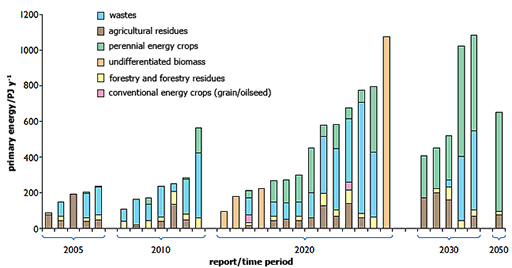10 Future prospects for bioenergy
Bioenergy is the world’s largest source of renewable energy and the fourth most important source of energy overall, delivering a total of 59.2 EJ or 10.3% of global energy in 2014 (WBA, 2017). More than 90% of bioenergy is used in heating: both direct heating including traditional biomass use and derived heating in Combined Heat and Power (CHP) plants.
IEA projections based on the commitments in the Paris Agreement see limited growth in renewable heat (from 9% in 2015 to 15% in 2040) as well as biofuel in transport (from 3% in 2015 to 8% in 2040), while maintaining a 2% share of electricity generation in an expanding market. With a more aggressive approach to emissions reductions scenarios the growth could be considerably greater but it is not clear that the necessary policy frameworks will be put in place globally though regional actors such as the European Union may be more ambitious.
A range of studies reviewed by the Imperial College Centre for Energy Policy and Technology (Slade et al., 2010) suggest that a rise from some 250 PJ per annum from bioenergy to perhaps 600 PJ by 2030 seems possible. As shown in Figure 12, the two sources suggested as having most potential for increased production by 2030 are wastes and perennial energy crops such as SRF/SRC.

In the developing countries, future demand for biomass energy is likely to be determined mainly by two opposing factors:
- the rise in overall energy demand due to increasing population
- the reduction in the demand for traditional forms of biomass due to a shift to more ‘modern’ forms.
Most projections suggest that biomass consumption will continue to rise during the next few decades, but at a lower rate than renewables in general or total primary energy. Nevertheless traditional biomass will remain the sole domestic fuel for a large proportion of the world’s population – more than a third of whom rely on solid biomass for cooking (IEA, 2016) - for a long time to come. It is therefore arguable that the improvement of traditional wood and charcoal stoves should be the most important technical aim in the field of bioenergy today: improving safety, reducing harmful emissions and reducing costs for some of the world’s poorest people.
Activity 4 Needs for energy and needs for food
In the medium term what factors are likely to increase competition for land between needs for energy and for food?
Answer
Population growth and changing diets look the most likely. It has been suggested that, after allowing for increased food production for a growing world population, as much as 400–700 million additional hectares could be available for energy crops worldwide in the year 2050, without unacceptable loss of biodiversity (UNDP, 2000). Other sources suggest a much lower figure.
The most optimistic recent forecast for the potential future contribution of bioenergy suggests over 1500 EJ per year, way beyond total current world energy. A more widely accepted figure might be of the order of 100–200 EJ of bioenergy per year. 200 EJ would represent a fivefold increase on current levels – a new contribution equal to over a fifth of present world total primary energy consumption.
Next you can try the mid-course quiz.
